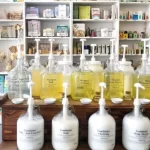The Future of Sustainable Bath Products: Innovations and Trends
As our collective awareness of environmental sustainability grows, so does the demand for eco-conscious products across various industries. The world of bath products is no exception, with consumers increasingly seeking sustainable alternatives that promote both personal well-being and planetary health. In this article, we’ll dive into the exciting realm of sustainable bath products, exploring the innovations and trends that are shaping the future of our daily self-care routines.
1. Clean and Transparent Ingredients
Natural Formulations: The future of sustainable bath products is rooted in clean, natural formulations. Consumers are scrutinizing ingredient lists, opting for products free from parabens, sulfates, and artificial fragrances.
Transparency: Brands are responding by providing transparent information about sourcing and production processes. Certification standards like “Certified Organic” and “Cruelty-Free” are becoming more prevalent, assuring consumers of the ethical and sustainable practices behind their products.
Benefits of using natural and sustainable bath products.
Using natural and sustainable bath products offers numerous benefits for both your well-being and the environment. Here are ten key advantages:
- Gentle on Skin: Natural ingredients are less likely to cause skin irritation or allergies, making them suitable for sensitive skin types.
- Chemical-Free: Sustainable products often avoid harsh chemicals, reducing exposure to potentially harmful substances.
- Eco-Friendly: Sustainable bath products are produced with minimal environmental impact, conserving resources and reducing pollution.
- Cruelty-Free: Many sustainable brands avoid animal testing, promoting ethical treatment of animals.
- Biodegradable: Natural ingredients and eco-friendly packaging decompose easily, reducing long-term environmental waste.
- Reduced Carbon Footprint: Sustainable production processes often involve fewer emissions and energy consumption, helping combat climate change.
- Supports Ethical Practices: Sustainable brands often prioritize fair trade and ethical sourcing, benefiting local communities.
- Healthier Waterways: Eco-friendly ingredients and minimal chemical runoff contribute to cleaner water sources.
- Aromatherapy Benefits: Natural scents and essential oils used in sustainable products can have therapeutic effects, promoting relaxation and stress relief.
- Positive Consumer Impact: Supporting sustainable brands encourages responsible consumer choices and helps drive industry-wide change toward eco-consciousness.
2. Minimalist Packaging

Reducing Plastic Waste:
Innovations in packaging design are geared towards minimizing plastic waste. Expect to see more brands adopting biodegradable or recyclable materials and compact, minimalist packaging.
How Single-Use Plastic Harming the Environment:
- Persistent Pollution: Single-use plastic items, such as bags and bottles, persist in the environment for hundreds of years, cluttering landscapes, oceans, and waterways.
- Wildlife Endangerment: Animals often ingest or become entangled in plastic waste, leading to injury and death. Marine life, in particular, is threatened by plastic pollution.
- Microplastics: Over time, larger plastic items break down into smaller particles called microplastics, which can enter the food chain, potentially harming both marine and terrestrial organisms.
- Resource Depletion: The production of single-use plastic consumes valuable fossil fuels and natural resources, contributing to resource depletion and increased carbon emissions.
- Toxic Chemicals: Plastics can leach toxic chemicals into the environment, posing health risks to humans and wildlife.
How Biodegradable or Recyclable Materials Packaging Impacting on the Environment:
- Reduced Pollution: Biodegradable materials break down naturally without leaving harmful residues, reducing long-term environmental pollution.
- Less Waste: Biodegradable and recyclable materials result in less waste in landfills, reducing the need for landfill expansion and associated environmental problems.
- Lower Carbon Footprint: Sustainable packaging materials often require less energy to produce, lowering carbon emissions and mitigating climate change.
- Conservation of Resources: Using recyclable materials promotes resource conservation, as it reduces the need for virgin materials and energy in manufacturing.
- Supporting Recycling Industry: The use of recyclable materials encourages the growth of recycling infrastructure and industries, contributing to a circular economy.
- Biodiversity Protection: Sustainable materials reduce the risks of harm to wildlife and ecosystems, promoting overall environmental health.
- Consumer Awareness: Biodegradable and recyclable packaging educates consumers about eco-conscious choices, fostering a more environmentally responsible mindset.
Refill Stations:
A growing trend is the introduction of refill stations at physical stores, allowing customers to replenish their bath products using reusable containers, reducing the need for single-use plastic bottles. Some companies like Fill & Refill, The Refill Shoppe, and The Unwaste Shop is dowing fantastic job.

The Benefits of Products Refill Stations:
Bathing products refill stations offer several benefits, both for consumers and the environment:
- Reduced Plastic Waste: Refill stations help significantly reduce the consumption of single-use plastic containers, leading to less plastic waste in landfills and oceans.
- Environmental Conservation: By reducing the need for new plastic production, refill stations contribute to resource conservation and reduce carbon emissions associated with plastic manufacturing.
- Cost Savings: Consumers can save money by refilling their existing containers instead of purchasing new ones, making sustainable products more affordable.
- Customization: Refill stations often offer a variety of product options, allowing consumers to choose specific scents, formulations, or quantities that suit their preferences.
- Convenience: Refill stations are typically located in convenient locations, making it easier for consumers to access eco-friendly products without traveling to specialty stores.
- Promotes Sustainable Practices: By using refill stations, consumers are encouraged to adopt sustainable shopping habits and reduce their environmental footprint.
- Supports Local Businesses: Many refill stations are operated by local businesses, contributing to the growth of eco-conscious entrepreneurs and the local economy.
- Minimal Packaging: Refill stations often use bulk containers for their products, which require less packaging overall, reducing waste and environmental impact.
- Education: Refill stations can serve as educational platforms, raising awareness about the environmental consequences of single-use plastics and promoting eco-friendly alternatives.
- Community Building: Refill stations can become hubs for like-minded individuals who are passionate about sustainability, fostering a sense of community and shared environmental responsibility.
3. Water-Conserving Formulas
Concentrated Formulas: To address water scarcity concerns, sustainable bath products are shifting towards concentrated formulas. These products require less water during manufacturing and are packaged in smaller containers, reducing their environmental impact.
4. Sustainable Sourcing
Ethical Ingredients: Brands are increasingly prioritizing ethical sourcing of ingredients. They’re forging partnerships with local communities and emphasizing fair trade practices to ensure that sourcing has a positive impact on both people and the environment.
5. Solid and Bar Formats
Shampoo Bars and Solid Soaps: Solid formats, such as shampoo bars and solid soaps, are gaining popularity. They require less water in their production, have minimal packaging, and are travel-friendly. You can also find the best bathing soaps for fair skin.
Bath Oil Bars: These bars, infused with essential oils, offer a luxurious bath experience without the need for liquid bath oils, reducing plastic waste.
6. Personalization
Customizable Products: Some brands are offering personalized bath products, allowing consumers to choose their preferred scents and ingredients. This reduces waste by ensuring that products align with individual preferences.
7. Sustainable Certification
Eco-Certifications: Look for more bath products to display eco-certifications like “Fair Trade Certified,” “Leaping Bunny,” and “USDA Organic,” assuring consumers of their sustainability and ethical practices.
Conclusion: A Greener, More Sustainable Bathing Future
The future of viable bath products is promising and aligns with our growing commitment to environmental responsibility. With innovative formulations, eco-conscious packaging, and a focus on ethical sourcing, these products not only contribute to personal well-being but also support a healthier planet. As consumers continue to demand sustainability, the bath product industry is poised to lead the way towards a greener, more sustainable bathing future.


